|
|
Advertisement:
|
|
GIGABYTE 990FXA-UD7 Motherboard |
|
Join the community - in the OCAU Forums!
|
Motherboard & BIOS Features
Motherboard Features:
GIGABYTE has implemented a variety of technologies with the 990FXA-UD7. The core features and components include:
Ultra Durable 3 technology includes a 2oz copper design for a lower working temperature and a reduction of hotspots, better overclocking, better power efficiency allowing electric current to flow with less resistance and enabling more power efficient circuits with lower power loss and less heat generated. You will find the majority of GIGABYTE motherboards sporting at least the 'Classic' version, whereas high-end models like this will up the ante even more by including Japanese solid capacitors, Driver MOSFETs and Ferrite Core Chokes alongside improved power circuitry from top to bottom.
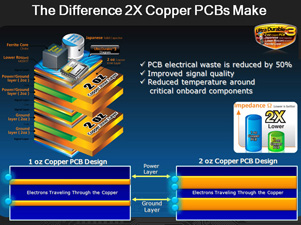 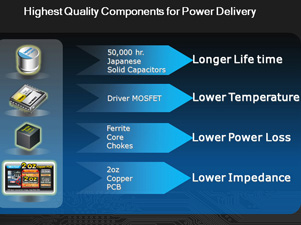
SATA 3.0 6Gb/s is a native solution implemented by AMD in their 900-series chipsets, but GIGABYTE have taken it a step further by including another two SATA 3.0 6Gb/s ports (right of the black ports), joining the six SATA 3.0 (black) ports driven by the SB950 chipset natively. The extra two ports are driven by Marvell's SE9172 controller, the same model as the controller included at the back of the motherboard for the 6GB/s eSATA port.
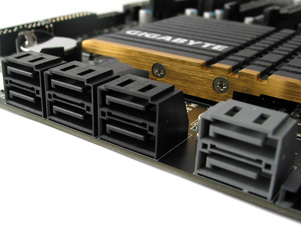 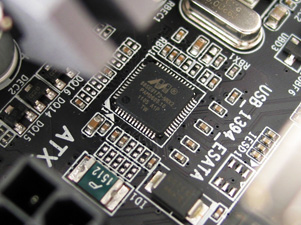
8+2 Power Phase Design includes eight of the latest Driver MOS MOSFETs, while the additional '+2' phases are an older style MOSFET. These are all hidden under the heatsinks around the socket area. Right next to the power delivery, we have the new AM3+ socket. The new socket comes with a black design making it easy to spot, an upgraded data link between the CPU and PWM, more efficient power load line with better power efficiency and support up to 145A of current, compared to the existing 110A specification. The heatsink retention bracket has also been redesigned, however it still supports existing AM3 based mounts.
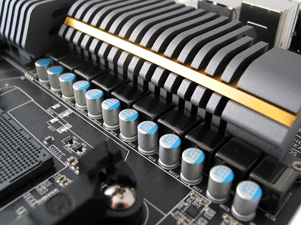 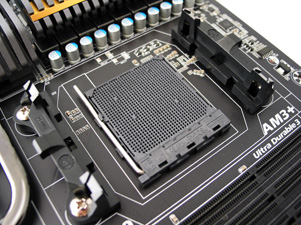
Onboard quick switches and debug LED's are placed conveniently on the right edge of the motherboard. The three push-button switches are illuminated in a purple-ish blue while the debug LED maintains a classic red colour. The three switches are constantly illuminated, while the debug LED is disabled upon shutdown. There are no other visible LEDs on the motherboard that were noticed during testing.
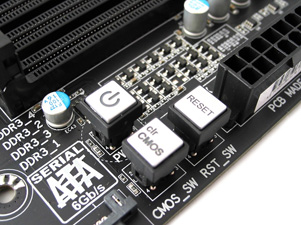 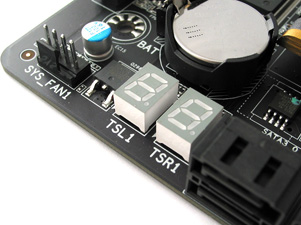
4-Way CrossfireX and SLI support is one of the key features that differentiates this new series of chipsets from older models in the AMD range. Previously users has to settle for a single NVIDIA card, as SLI was not supported without some unofficial software workarounds, that is unless you were willing to settle for a second hand AMD motherboard that didn't support the latest processors for SLI support. Now SLI support is officially back, meaning users are no longer limited to an Intel-only solution for multi-GPU NVIDIA configurations. Of course, AMD CrossfireX is supported also by default.
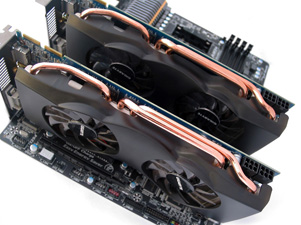 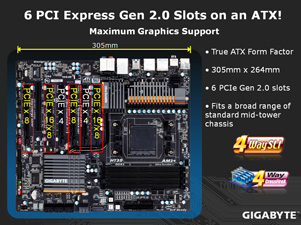
Dual USB 3.0 controllers are present, one being utilised for the two USB 3.0 ports on the back I/O panel, while the second takes care of the front USB 3.0 hub. Unlike the majority of motherboards that choose a NEC based solution, GIGABYTE have gone for two EtronTech EJ168A controllers, which from various tests around the net, can gain up to 6% of performance compared to the NEC alternative.
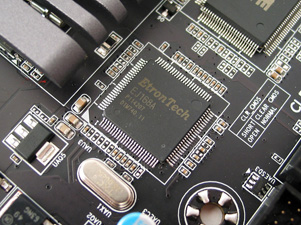 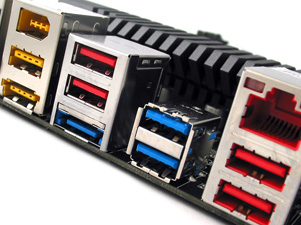
8-pin EPS and ATX4P connectors help the CPU and video cards get as much power as required. The 8-pin EPS connector is a common sight on motherboards these days, while the ATX4P first came across our radar with the introductions of GIGABYTE's GA-X58A-OC, allowing for more power to be delivered to the video cards. This is especially handy when running four cards and pushing their overclocking abilities.
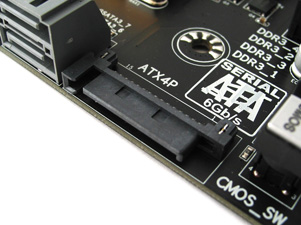 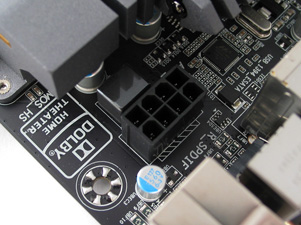
DualBIOS - This now familiar feature includes a second BIOS chip on the motherboard. If something goes wrong during a BIOS flash, the system will automatically revert to a previous version stored on the backup BIOS chip without hesitation. Not far below that we have the illuminated Debug LED panel; especially helpful during boot and system diagnostics. GIGABYTE has also been able to include 3TB+ hard drive support without the need to move to a full UEFI BIOS.
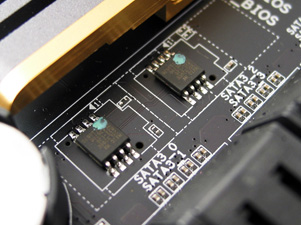 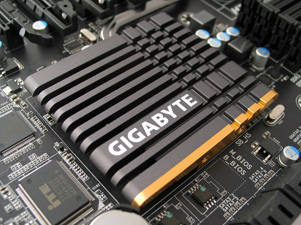
Realtek Audio and Network - The 990FXA-UD7 incorporates the Realtek ALC889 audio codec with 7.1-channel support as well as Dolby Home Theatre technologies. For network connectivity they include one Realtek RTL8111E network processor, and while we would have liked to see a second gigabit connection, one will suffice for most home users.
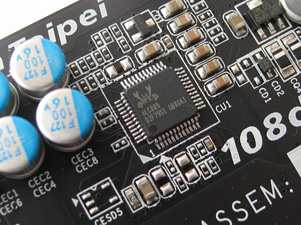 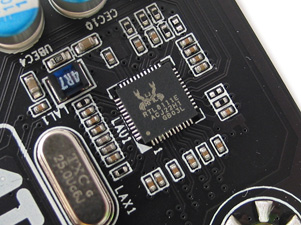
ON/OFF Charge Technology provides a set of white and red coloured USB pin headers that can easily be connected to your system's front USB 2.0 ports allowing extra amperage for your iPhone, iPod Touch, iPad to charge correctly. Unlike traditional designs GIGABYTE's ON/OFF technology will allow your devices to keep charging even while your PC is off or in a variety of standby modes.
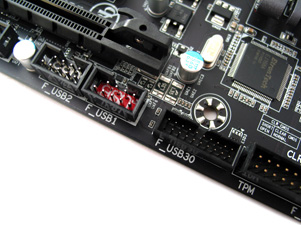 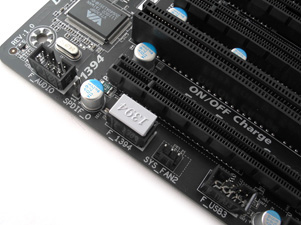
Here's the onboard quick switches and debug LEDs while powered on:
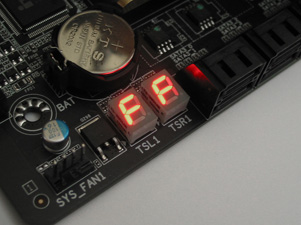 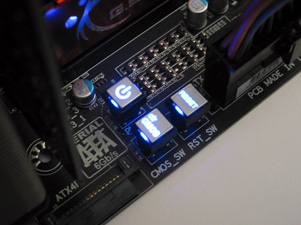
BIOS Features:
The GIGABYTE 990FXA-UD7 utilises an Award Software BIOS, updated to version F4b, which is one of the latest BIOS update available at the time of writing this review. The core menu screenshots are included below.
System boot and main BIOS screen:
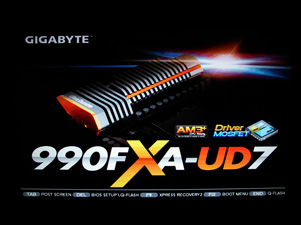 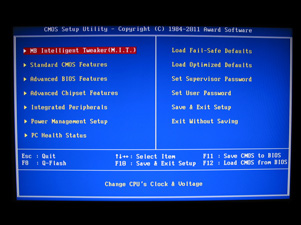
M.I.T. Intelligent Tweaker menu:
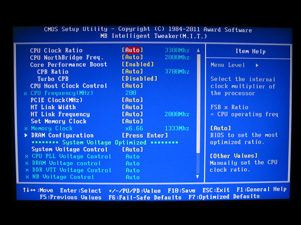 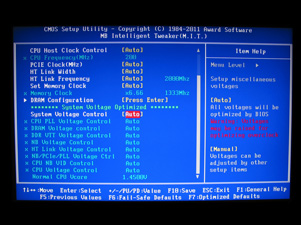
DRAM Configuration menu:
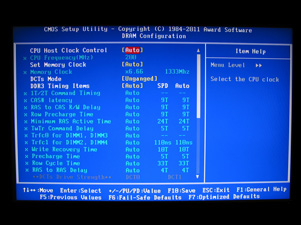 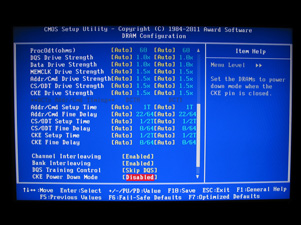
Standard CMOS and Advanced BIOS Features:
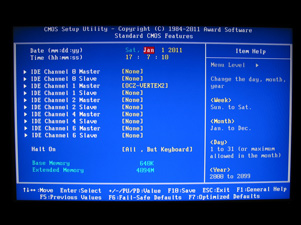 
Advanced BIOS Features continued:
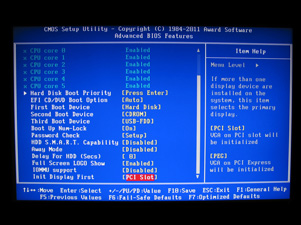 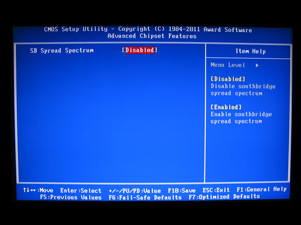
Integrated Peripherals and Onboard PCIE Devices:
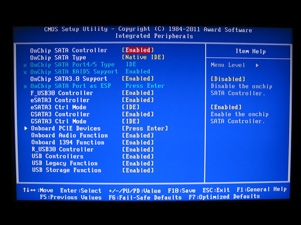 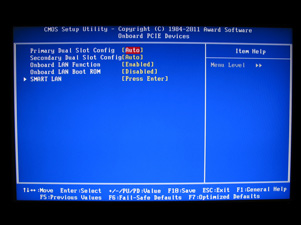
Power Management Setup and PC Health Status menu:
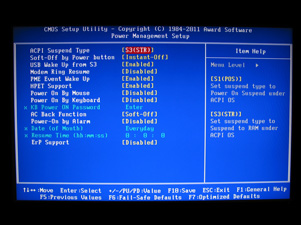 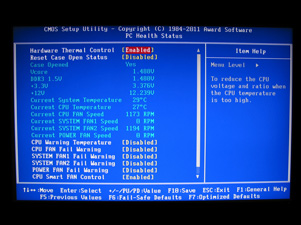
|
|
Advertisement:
All original content copyright James Rolfe.
All rights reserved. No reproduction allowed without written permission.
Interested in advertising on OCAU? Contact us for info.
|

|


